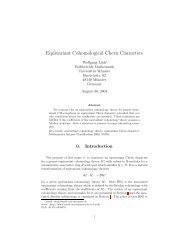Connes-Chern Character for Manifolds with Boundary and ETA ...
Connes-Chern Character for Manifolds with Boundary and ETA ...
Connes-Chern Character for Manifolds with Boundary and ETA ...
You also want an ePaper? Increase the reach of your titles
YUMPU automatically turns print PDFs into web optimized ePapers that Google loves.
42 MATTHIAS LESCH, HENRI MOSCOVICI, AND MARKUS J. PFLAUM<br />
p = 2. We estimate the L 2 -norm of the kernel on R × R by:<br />
∫ ∫<br />
1<br />
(x−y)2<br />
−2α|x|−<br />
e 2t +2β|y| dxdy<br />
4πt R R<br />
≤ 1 ∫ ∫<br />
e −2α|x| e − z2<br />
2t +2β|z|+2β|x| dzdx<br />
4πt R<br />
R<br />
≤ √ 1 ∫<br />
e −2(α−β)|x| e 2β2t dx<br />
2πt<br />
= √ 1 1<br />
2πt α − β e2β2t ,<br />
proving the result <strong>for</strong> l = 0 <strong>and</strong> p = 2. Again, the case l = 1 is similar.<br />
R<br />
p = 1. Put c = (α + β)/2. Then the semigroup property of the heat kernel gives<br />
‖e −α|X| e −t∆ R<br />
e β|X| ‖ 1<br />
≤ ‖e −α|X| e −t/2∆ R<br />
e c|X| ‖ 2 ‖e −c|X| e −t/2∆ R<br />
e β|X| ‖ 2 ,<br />
<strong>and</strong> using the proved case p = 2 gives the result <strong>for</strong> p = 1.<br />
(3.25)<br />
(3.26)<br />
The previous Proposition <strong>and</strong> st<strong>and</strong>ard estimates <strong>for</strong> the heat kernel on closed manifolds<br />
(cf. the Appendix B) immediately give the following result <strong>for</strong> the heat kernel of<br />
the model Dirac operator on the cylinder.<br />
Proposition 3.7. Let N be a compact closed manifold <strong>and</strong> D = Γ ( d<br />
+ A) a<br />
dx<br />
Dirac operator on the cylinder M = R × N (cf. Remark 1.10). Furthermore, let<br />
Q ∈ b Diff q cpt((−∞, 0) × N; W ) a b-differential operator of order q <strong>with</strong> support in<br />
some cylindrical end (−∞, c) × N. Then <strong>for</strong> α > β > 0, t > 0 the integral operator<br />
e −α|X| Qe −tD2 e β|X| <strong>with</strong> kernel<br />
1<br />
√ e −α|x| Q x e −(x−y)2 /4t+β|y| e −tA2 (3.27)<br />
4πt<br />
is p-summable <strong>for</strong> 1 ≤ p ≤ ∞. Furthermore, <strong>for</strong> ε > 0, t 0 > 0, there is a constant<br />
C(ε, t 0 ), such that <strong>for</strong> 1 ≤ p ≤ ∞, 0 < t < t 0 , 0 < β < α<br />
‖e −α|X| Qe −tD2 e β|X| ‖ p ≤ C(ε, t 0 )(α − β) −1/p dim M+ε<br />
− −<br />
t q 2p 2 . (3.28)<br />
If in addition the operator A is invertible then <strong>for</strong> 0 < δ < inf spec A 2 <strong>and</strong> ε > 0 there<br />
are constants C j (δ, ε), j = 1, 2 such that <strong>for</strong> 1 ≤ p ≤ ∞, 0 < t < ∞, 0 < β < α we<br />
have the estimate<br />
□<br />
‖e −α|X| Qe −tD2 e β|X| ‖ p<br />
≤ ( C 1 (δ, ε)t − q 2 + C2 (δ, ε) ) (α − β) −1/p dim M+ε<br />
−<br />
t<br />
2p<br />
e (α2 +β 2−δ)t . (3.29)<br />
For the definition of b Diff q cpt, b Diff q see Proposition A.1 <strong>and</strong> Eq. (A.16).<br />
Proof. By Proposition A.1 we may write Q as a sum of operators of the <strong>for</strong>m<br />
( d<br />
) l<br />
f(x, p)P<br />
(3.30)<br />
dx<br />
<strong>with</strong>

















